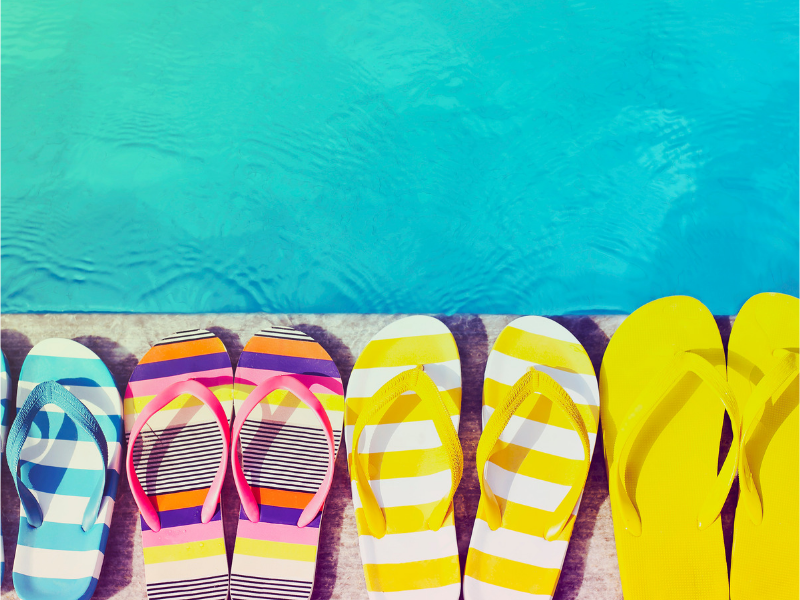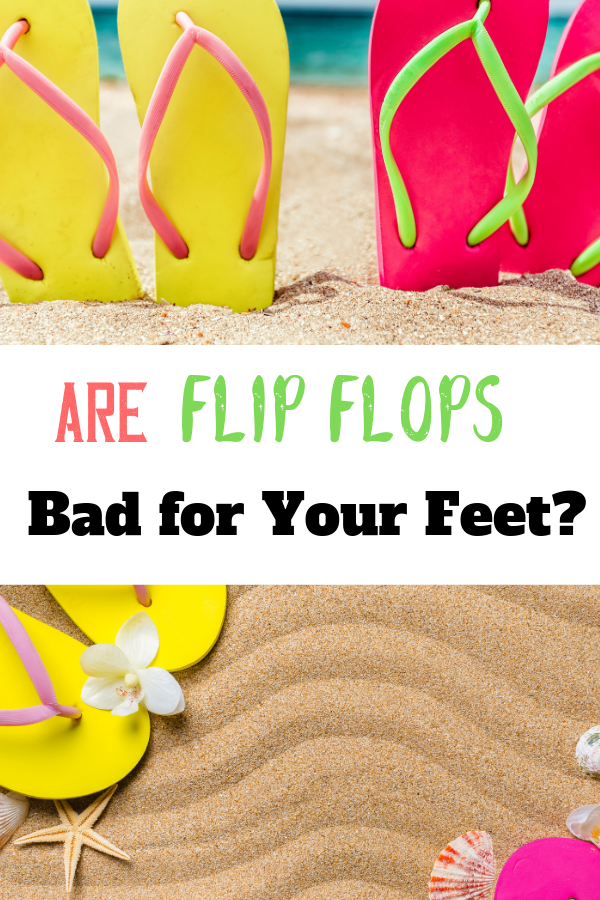
Are Flip Flops Bad for Your Feet?
Flips flops are a staple in everyone’s summer wardrobe. True story – my kids have been buying these on their own for years. Who can blame them? They are inexpensive and easy to toss on and also cute. Once I wrote about the time my older girl zip lined through Puerto Vallarta rain forest wearing flip flops.

Oh so popular during the summer months and when you go on holidays, flip flops are inexpensive and easy to pack. It’s no wonder people love this popular form of footwear. They are easy and flexible and they scream beach vacation.
Table of Contents
But Are They Good, or Bad, For Feet?
Formerly reserved for the beach, community showering facilities, or the gym locker room, flip flops have found their way into day-to-day wardrobes. They can often revamped for dressier occasions.

Despite the popularity of the shoe, people who wear flip flops on a regular basis, or those who wear flip flops as their go-to footwear, are doing more harm than good to their feet, knees, and legs. While wearing flip flops in moderation may not make a difference, habitual flip flop wearers may find a variety of aches, pains, and conditions that are associated with their favourite footwear. In fact, your body may even alter the way in which you walk if you wear flip flops a lot.
Study Finds that Flip Flops Cause Pain in Feet, Legs, and Back
Flip flops, by nature, are not a very protective shoe. They lack any structure at the back of the foot to provide ankle support and are usually made from thin rubber or foam-like materials, which provides little cushion while walking. Additionally, flip flops made with the traditional squishy foam are likely to absorb water and create a slippery surface to walk on, especially when floors or sidewalks are wet as well.

A study done by Auburn University found that wearing flip flops alters the way you walk. This can cause back, leg, knee, and foot pain for those who habitually wear the popular shoe. Newsweek reports that Auburn doctoral student Justin Shroyer and biomechanics laboratory director Dr. Wendi Weimar were discussing ideas for a research project when the two decided to examine the way humans walk when wearing flip flops versus other shoes.
Shroyer and Weimar collected a random sample of thirty-nine college students, both male and female, and had them wear flip flops while walking on a special platform. This platform measured the amount of pressure that was applied each time a foot hit the ground. Additionally, Shroyer and Weimar recorded study participants while they were walking to document the movements of their feet, legs, and hips.
Shorter Steps Equal Risk of Pain
What data collected from the platform tests and video recordings showed is that people wearing flip flops take shorter steps. That means the body has to do more work to move the same amount of distance when a person is wearing flip flops versus athletic shoes. Since the body is doing more work than usual for that activity, the risk of pain and injuries to the muscles, tendons, and joints that the human body uses to walk increases.
Scrunching Toes
The structure of the flip flop also caused a problem. “When you wear flip-flops, you kind of scrunch your toes to keep the flip-flop on your foot,” Shroyer told Newsweek. This constant scrunching causes certain muscles to tense. Over time this can cause pain in your toes.

Benefits of Flip Flops
Surprisingly, there are some benefits to wearing flip flops, despite the potential for pain and damage their use has on toes, ankles, feet, legs, and knees.
Good For Showers
For ages, camp counselors, college and university personnel, fitness center owners, and even branches of the military throughout the world have recommended wearing flip flops while using public showers. The flip flop’s structure allows people to still wash their feet while preventing skin infections from public facilities. Since these shoes are also relatively inexpensive, they can also be disposed of and replaced if infections or illnesses break out as a result of public showers.
Another Study
A study conducted by Rush Medical Center in Chicago, Illinois, has also found that wearing flip flops in moderation may be helpful for people who have arthritis. People who have arthritis, the study showed, had less stress on their knees as a result of wearing flip flops versus any other kind of shoe, even athletic shoes, according to one CNN report.
However, Rush has also indicated you should not wear them if you have planter fasciitis.
Alternative Shoe Options
Sandals in general have been worn for centuries and date back thousands of years. Podiatrists and researchers, however, recommend that people wear flip flops in moderation to prevent pain and damage to their feet and legs.
When looking for summer sandals, podiatrists recommend finding a pair that has a cup-like structure to support the ankle as a person walks. It’s ideal to wear shoes that have a secure way of fastening onto the person’s foot. This prevents the toes from scrunching up to keep the shoes on and allow people to walk with a more natural stride.
As Always Moderation is Key
As warmer weather arrives, flip flops continue to be a popular summer foot wear option for those who have toes that need sun too. Fans of these shoes, however, should be careful to wear their beloved shoes in moderation to prevent injuries and pain in their toes, ankles, feet, legs, and other body parts. Excessive flip flop wear is not beneficial for your feet.
Post may contain affiliate links as a service to readers. Purchases made via qualifying links equal a small commission for me.




2 Comments
MD Kennedy
My mother never let us wear flip-flops. If we did not want to wear shoes or sneakers, we went barefoot. Now that I am older, I get disgusted with younger folks wearing flip-flops to the office! I am of the old rule that says if you would wear it to the beach or working in your yard, it doesn’t belong in the office!
Paula
To the office? Really? That seems like a stretch on what’s allowed for casual day, doesn’t it?